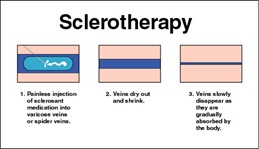What are Spider Veins?
Spider veins are small size varicose veins just under the surface of the skin, most commonly on the lower extremities.
What causes spider veins?
Spider veins are more common in women than men,as the vast majority are due to hormonal changes, e.g menstrual cycles, pregnancy, menopause,oral contraceptives, and hormonal replacement.
Other causes are trauma to the area, as neovascularization, or new vein development, occurs to help the healing process by increasing blood flow to the injured area.
Capillary permeability or weak vein walls will allow for spontaneous vein rupture, starting as a bruise, and then new spider veins develop, again as part of the healing process. This can be avoided by adding flavinoids to the diet, either by using mineral supplements, e.g hesperidin, and diosomin, or by eating the white rind of citrus fruits, e.g grapefruit, oranges, and even lemons.
Spider veins may also be secondary to venous insufficiency – bulging varicose veins and as a result of blood leakage from these varicose veins.
How do you treat spider veins?
Treatment of spider veins will depend on the cause. Sclerotherapy is the most common option, and depending on the vein size, can be either liquid or foam (liquid with the addition of air). Foam is used for the larger size veins to enhance the treatment outcomes. Special lighting (VeinLite), and magnification are used to increase precision. VeinGogh , ohmic thermolysis or thermocoagulation, can be used if these veins are of small size.
If there is an underlying venous insufficiency, that needs to be treated first. This is often done with endovenous laser ablation, and once the venous insufficiency problem is solved, then sclerotherapy can be successfully utilized.
For a consultation for your spider veins with NYC’s top doctor for varicose veins, call Dr. Chideckel today!



